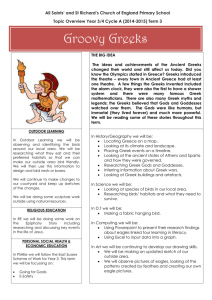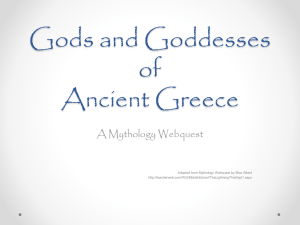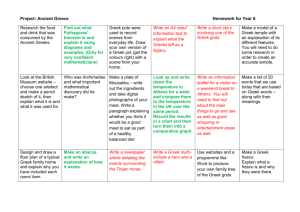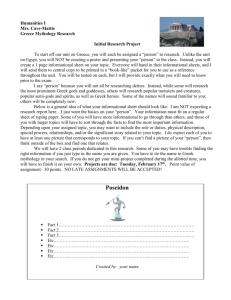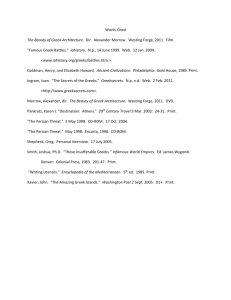“Mythology and Gods
advertisement
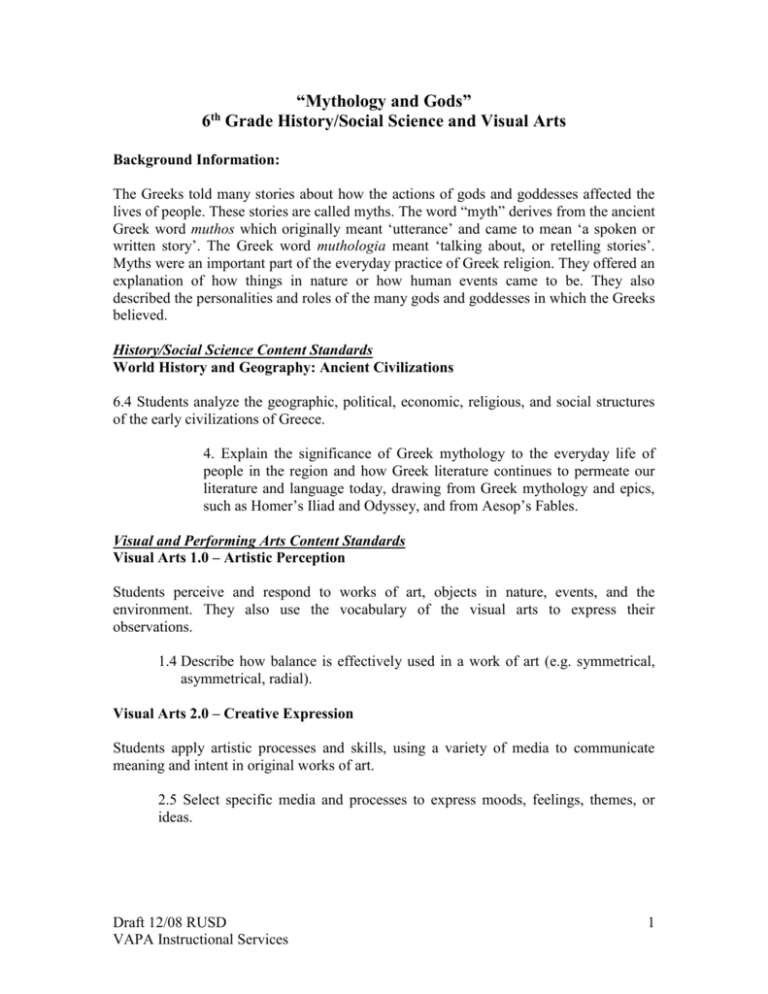
“Mythology and Gods” 6 Grade History/Social Science and Visual Arts th Background Information: The Greeks told many stories about how the actions of gods and goddesses affected the lives of people. These stories are called myths. The word “myth” derives from the ancient Greek word muthos which originally meant ‘utterance’ and came to mean ‘a spoken or written story’. The Greek word muthologia meant ‘talking about, or retelling stories’. Myths were an important part of the everyday practice of Greek religion. They offered an explanation of how things in nature or how human events came to be. They also described the personalities and roles of the many gods and goddesses in which the Greeks believed. History/Social Science Content Standards World History and Geography: Ancient Civilizations 6.4 Students analyze the geographic, political, economic, religious, and social structures of the early civilizations of Greece. 4. Explain the significance of Greek mythology to the everyday life of people in the region and how Greek literature continues to permeate our literature and language today, drawing from Greek mythology and epics, such as Homer’s Iliad and Odyssey, and from Aesop’s Fables. Visual and Performing Arts Content Standards Visual Arts 1.0 – Artistic Perception Students perceive and respond to works of art, objects in nature, events, and the environment. They also use the vocabulary of the visual arts to express their observations. 1.4 Describe how balance is effectively used in a work of art (e.g. symmetrical, asymmetrical, radial). Visual Arts 2.0 – Creative Expression Students apply artistic processes and skills, using a variety of media to communicate meaning and intent in original works of art. 2.5 Select specific media and processes to express moods, feelings, themes, or ideas. Draft 12/08 RUSD VAPA Instructional Services 1 Visual Arts 3.0 – Historical and Cultural Context Students analyze the role and development of the visual arts in past and present cultures throughout the world, noting human diversity as it relates to the visual arts and artists. 3.1 Research and discuss the role of the visual arts in selected periods of history, using a variety of resources (both print and electronic). Visual Arts 5.0 – Connections, Relationships, Applications Students apply what they learn in the visual arts across subject areas. They develop competencies and creative skills in problem solving, communication, and management of time and resources that contribute to lifelong learning and career skill. They also learn about careers in and related to the visual arts. 5.3 Create an artwork containing visual metaphors that express the traditions and myths of selected cultures. Learning Objectives: Students will discuss and gain an understanding of mythology and its importance in the everyday practice of Greek religion. Students will learn the vocabulary of art media and technique and demonstrate this by writing a critique of their artwork. Vocabulary: myth paper scoring symbolism template symmetrical mythology folding hieroglyphs personality asymmetrical legends form texture paper curling radial balance Materials: construction paper white glue scissors tools for scoring paper glue sticks mask template Motivation: Students will study the Ancient Greeks in 6th grade History/Social Science. This lesson gives them an opportunity to discuss, facilitate, and support what they have learned in History/Social Science and to gain new knowledge in visual arts. Students will have engagement with the History/Social Science information through the hands-on arts experience. Draft 12/08 RUSD VAPA Instructional Services 2 Visual Arts Content Lesson 1. Visual balance is the way that the different parts of a composition (work of art) relate to each other. Visual balance is very basic to art. The three types of visual balance are: a. Symmetrical balance - the design is exactly the same on both sides. Symmetrical balance is sometimes known as bilateral, two-sided, or formal balance. Compositions that display symmetry tend to be stable, dignified, and calm. b. Asymmetrical balance – two sides appear to have the same “visual weight”. An artist may place a large shape on one side of the composition, and balance it on the other side with a grouping of small shapes, or a small area of color on one side, balanced by a large colorless space on the other. Asymmetrical balance offers many different possibilities and combinations for creating visual balance in art. Asymmetrical balance is also called informal balance. Informal balance is something that the viewer senses in a composition; it cannot be measured. Learning to manipulate the visual elements in a design teaches you to judge when opposing elements are in balance. c. Radial balance – the design turns around a central point. Radial designs from a circular pattern and often convey a greater sense of movement or energy. Radial designs are generally orderly and repetitious and tend to create an overall decorative effect. 2. Why did the Greek gods and goddesses exist? Each Greek god and goddess possessed a special power or controlled a specific part of human life. a. Zeus –god of sky in all its moods (thunder, lighting, etc.) b. Hera – goddess/guardian of marriage and childbirth c. Athene – goddess of war d. Poseidon – god of the sea, earthquakes and horses e. Artemis – protected wild animals; goddess of childbirth f. Apollo – god of prophecy and healing associated with music and cultural activities and intellectual pursuits g. Ares – god of war h. Aphrodite – goddess of love i. Hephaestus – god of fire and blacksmithing j. Hermes – god of herds and herdsmen; messenger of the gods k. Pan – god of shepherds l. Demeter – goddess of corn and fertility m. Plutus – god of wealth n. Hades – god of the underworld o. Dionysos (Bacchus) – god of the wine and vegetation p. Hestia – goddess of hearth, fire, house, family and community Draft 12/08 RUSD VAPA Instructional Services 3 3. What type of symbols could represent the different Greek gods and goddesses? a. Zeus – lighting bolt, clouds b. Hera – babies, wedding ring c. Athene – spear, hammer, shield, sword d. Poseidon – water, shell, seaweed, fish e. Artemis – animals, baby carrier f. Apollo – music symbols, art symbols, books g. Ares – spear, hammer, shield, sword, helmet h. Aphrodite – hearts, cupids, bow and arrow i. Hephaestus – flames, blacksmith anvil and hammer j. Hermes – goats, sheep, wings k. Pan – herder’s staff, sheep l. Demeter – corn cobs, wheat, hops m. Plutus – coins, gold, precious stones n. Hades – pitchfork, horns, pointed teeth o. Dionysos (Bacchus) – grapes, fruit , vegetables p. Hestia – fireplace, home, family, representations of your community *(Students research a god or goddess that they are going to use for a mask.) 4. What are the different ways to use paper to create three dimensional designs/symbols for your mask? a. With a sharp instrument make a line in the paper that will create a clean fold. b. Take strips of paper and wind them around a pencil to create curled paper. c. Trace different shapes onto construction paper and glue them on mask base. d. Cut fringe and other designs in paper to use on mask. Procedure: 1. Class has studied Ancient Greeks and is introduced to Greek legends, myths, gods and goddesses (pages 282-283 in text). 2. Students pick the color to use for the base of the Greek god/goddess mask. 3. Cut mask template out of heavy paper for students to use as a template. 4. Using mask template cut out mask base from colored construction paper. 5. Cut, score, curl different colors of construction paper to glue on mask to create symbols of Greek god/goddess. 6. Write the name of the Greek god/goddess in Greek and attach it to the mask. Assessment and/or Evaluation: What do we want students to know? Students know what a representational mask is, and demonstrate this by creating original masks. Draft 12/08 RUSD VAPA Instructional Services 4 Students know the different Greek gods/goddesses and why they were created by the Greeks, and demonstrate this through class discussions. Students learn a variety of paper techniques, and demonstrate this by creating an original mask design. Students learn visual balance and demonstrate it by identifying the visual balance used in their masks. Students can self-assess (critique) their artwork using a formal rubric. Extensions: 1. Students write an essay about a Greek god/goddess that they created (characteristics/personality). 2. Students research what Greek deities became Roman deities and the name change. Draft 12/08 RUSD VAPA Instructional Services 5

